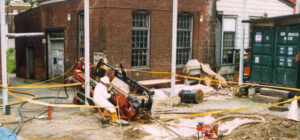Buying a property on contaminated land requires swift remediation in order to increase property value. Read on to learn more about how horizontal remediation wells are used to expedite the remediation process, limit the invasiveness of vertical wells, and how your contaminated site may benefit from evaluating horizontal soil remediation techniques.
Difficulties of Purchasing Property on Contaminated Land
Buying property on contaminated land can have both advantages and disadvantages. Purchasing contaminated land can offer cheaper prices than buying clean, undeveloped land. This affordability can attract investors or developers looking for potential cost savings. Conversely, a major concern in purchasing property on contaminated land is the potential health and environmental risks associated with the contamination. If no t properly addressed and effectively remediated, contaminated land can pose a threat to human and ecological health, leading to long-term liabilities and potential legal issues. The source of subsurface contamination, along with the bulk of the contamination plume, often resides beneath existing facilities on the property where it is not feasible for vertical remediation wells to gain appropriate access. A wide range of in situ remediation techniques may be applied to remediate contaminated soil and groundwater in the subsurface. The installation and utilization of horizontal remediation wells offer direct access to the source of the plume and ensure a rapid remediation process, which combines to raise property value.
t properly addressed and effectively remediated, contaminated land can pose a threat to human and ecological health, leading to long-term liabilities and potential legal issues. The source of subsurface contamination, along with the bulk of the contamination plume, often resides beneath existing facilities on the property where it is not feasible for vertical remediation wells to gain appropriate access. A wide range of in situ remediation techniques may be applied to remediate contaminated soil and groundwater in the subsurface. The installation and utilization of horizontal remediation wells offer direct access to the source of the plume and ensure a rapid remediation process, which combines to raise property value.
Advantages of Using Horizontal Wells for Contaminated Property Remediation
Horizontal remediation wells are frequently utilized to overcome the difficulties of purchasing property on contaminated land. The utilization of vertical wells falls short with each additional physical obstacle that the property contains, such as existing facilities or buildings at the surface, to buried utilities in the subsurface. Horizontal remediation wells provide solutions to overcome the difficulties that vertical wells face. Horizontal wells provide unmatched access to the source of the contamination plume through the use of directional drilling techniques. One horizontal remediation well can provide significantly more screen access to the contamination plume, effectively replacing multiple vertical wells in the remediation of contaminated land. More importantly, the source of the contamination plume can be accessed and remediated directly, which prevents additional contamination from evolving in the future. By providing access to the source of the contamination and an increased radius of influence to the plume as a whole, horizontal remediation wells provide a significantly more rapid contaminant cleanup and, therefore, an enhanced rate in property value.
Purchasing property on contaminated land can offer financial advantages and development potential, but it also carries significant health, environmental, and financial risks. Horizontal remediation wells are proven to provide the most access to the source of the contamination in order to ensure rapid remediation and an increase in property value. If you have a contaminated site that could benefit from horizontal remediation, please click HERE to tell us about your project so that we can help you determine whether horizontal remediation may be an effective solution to contaminated soil associated with your project.
Written by: Elliott Andelman P.G., Environmental Scientist